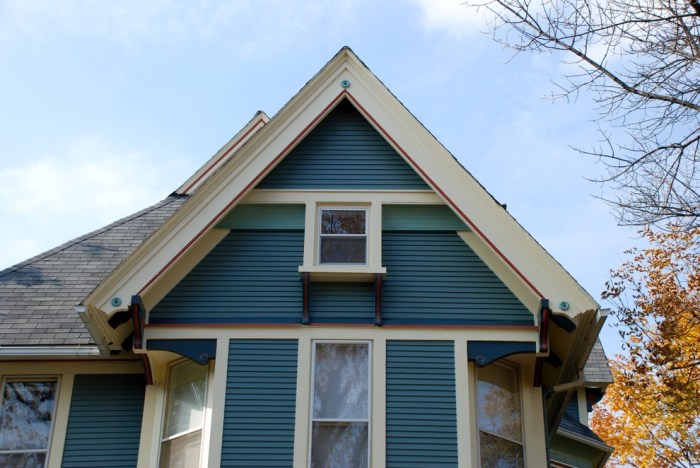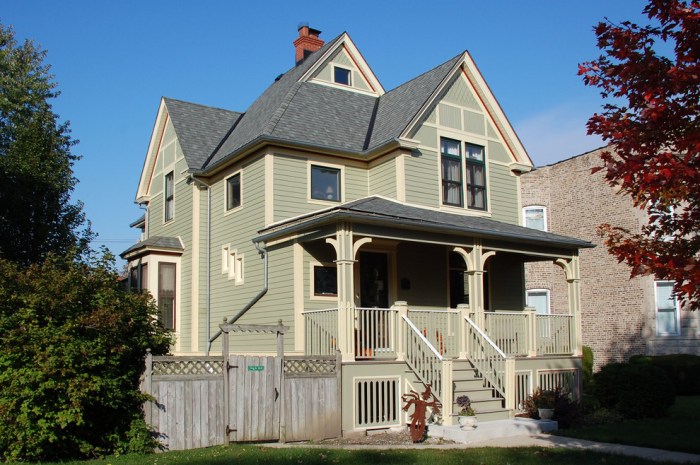Exploring Victorian Siding: A Detailed Guide
Delving into the world of Victorian siding, we unravel the history, styles, installation process, and maintenance of this classic architectural element. As we journey through the intricate patterns and materials, discover how Victorian siding can transform the look of any building.
Overview of Victorian Siding
Victorian siding refers to the decorative exterior cladding or siding used in Victorian-style architecture. It is known for its intricate designs, ornate details, and colorful combinations, adding character and charm to buildings.
The history of Victorian siding dates back to the Victorian era, which spanned from the mid-19th century to the early 20th century. During this time, rapid industrialization and advancements in manufacturing allowed for the mass production of building materials, including various types of siding options.
Common Materials Used in Victorian Siding
- Wood: Cedar, pine, and redwood were popular choices for Victorian siding due to their durability and ability to be intricately carved or shaped.
- Brick: Some Victorian homes featured brick siding, either as a primary cladding material or as accents to complement other siding types.
- Stucco: Stucco siding was commonly used in Victorian architecture, providing a smooth and textured finish that could be painted in vibrant colors.
- Scallop Shingles: These decorative shingles, also known as fish-scale or octagonal shingles, were often used to add a whimsical touch to Victorian homes.
- Ornamental Details: Victorian siding often incorporated decorative elements such as gingerbread trim, scrollwork, and intricate fretwork to enhance the overall aesthetic.
Styles and Designs

In Victorian architecture, siding plays a crucial role in defining the overall aesthetic of a building. The intricate designs and patterns of Victorian siding can truly enhance the charm and elegance of a structure.
Intricate Victorian Siding Patterns
Victorian siding is known for its variety of patterns and styles, each adding a unique touch to the facade of a building. Some popular examples include:
- Fish scale pattern: Resembling the scales of a fish, this design adds a whimsical and decorative element to the exterior.
- Scalloped shingles: These curved shingles create a softer and more romantic look, often seen in Victorian homes.
- Board and batten: Alternating wide boards with narrow strips, this design creates a dynamic and textured appearance.
Enhancing the Overall Look
Victorian siding can significantly enhance the overall look of a building by adding character, depth, and visual interest. The intricate patterns and designs create a sense of craftsmanship and attention to detail, making the structure stand out in a neighborhood or streetscape.
Whether it's a simple color variation or a complex pattern, Victorian siding can transform a plain exterior into a work of art.
Installation Process

Installing Victorian siding involves a step-by-step process that requires attention to detail and the use of specific tools. It is essential to be aware of common challenges that may arise during the installation to ensure a successful outcome.
Step-by-Step Installation
- Prepare the surface: Ensure the surface where the Victorian siding will be installed is clean and free of any debris or moisture.
- Measure and cut the siding: Take accurate measurements of the area to be covered and cut the siding panels accordingly.
- Start from the bottom: Begin installing the siding from the bottom up, making sure each panel is level and properly aligned.
- Overlap panels: Properly overlap each siding panel to ensure a seamless look and optimal protection against the elements.
- Secure panels: Use appropriate nails or screws to secure the siding panels in place, following the manufacturer's guidelines.
- Finish with trim: Complete the installation by adding trim pieces around windows, doors, and corners for a polished look.
Tools Required
- Hammer or nail gun
- Tape measure
- Circular saw or siding cutter
- Level
- Caulk and caulking gun
- Safety goggles and gloves
Common Challenges
- Uneven surfaces: Dealing with uneven surfaces can make the installation process more challenging and require additional preparation.
- Weather conditions: Adverse weather conditions can impact the installation, so it's essential to plan accordingly and work during suitable weather.
- Matching existing siding: Ensuring the new Victorian siding matches existing siding or architectural features can be a challenge that requires careful selection and planning.
Maintenance and Care
Maintaining and caring for Victorian siding is essential to ensure its longevity and aesthetic appeal. By following proper maintenance practices, you can preserve the beauty of your siding for years to come.
Cleaning and Upkeep
- Regularly clean the siding with a mixture of mild soap and water to remove dirt, grime, and mildew.
- Inspect the siding for any signs of damage, such as cracks, rot, or peeling paint, and address them promptly.
- Consider applying a fresh coat of paint or sealant every few years to protect the siding from the elements.
- Avoid using harsh chemicals or abrasive materials that can damage the siding's surface.
Common Issues and Solutions
- Moisture damage: Ensure proper drainage around the siding to prevent water from seeping in and causing rot. Repair any leaks or gaps to maintain the integrity of the siding.
- Pest infestations: Inspect the siding regularly for signs of insect or rodent activity. Use pest control measures to prevent damage to the siding.
- Paint peeling: If you notice paint peeling or chipping, scrape off the old paint, sand the surface, and apply a new coat of paint to protect the siding.
- Warping or buckling: Address any warping or buckling of the siding boards by replacing damaged sections and ensuring proper installation.
Closing Summary
In conclusion, Victorian siding offers a timeless charm and elegance to any structure it adorns. With proper maintenance and care, this architectural feature can stand the test of time, adding character and beauty to your property for years to come.
FAQ
What materials are commonly used in Victorian siding?
Common materials used in Victorian siding include wood, vinyl, fiber cement, and synthetic stone.
How can I maintain Victorian siding?
To maintain Victorian siding, regularly clean it with a mild detergent, inspect for damage or rot, and repaint or seal as needed.
What are some common challenges during the installation of Victorian siding?
Common challenges during installation include ensuring proper alignment of the siding panels, dealing with uneven surfaces, and weather-related issues.




